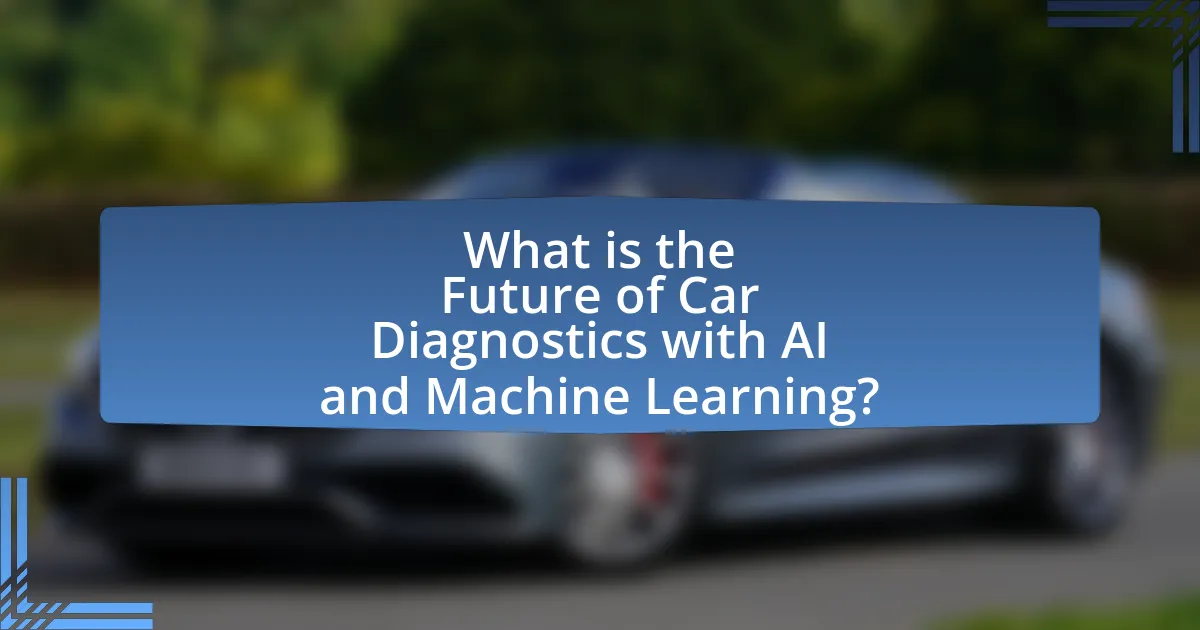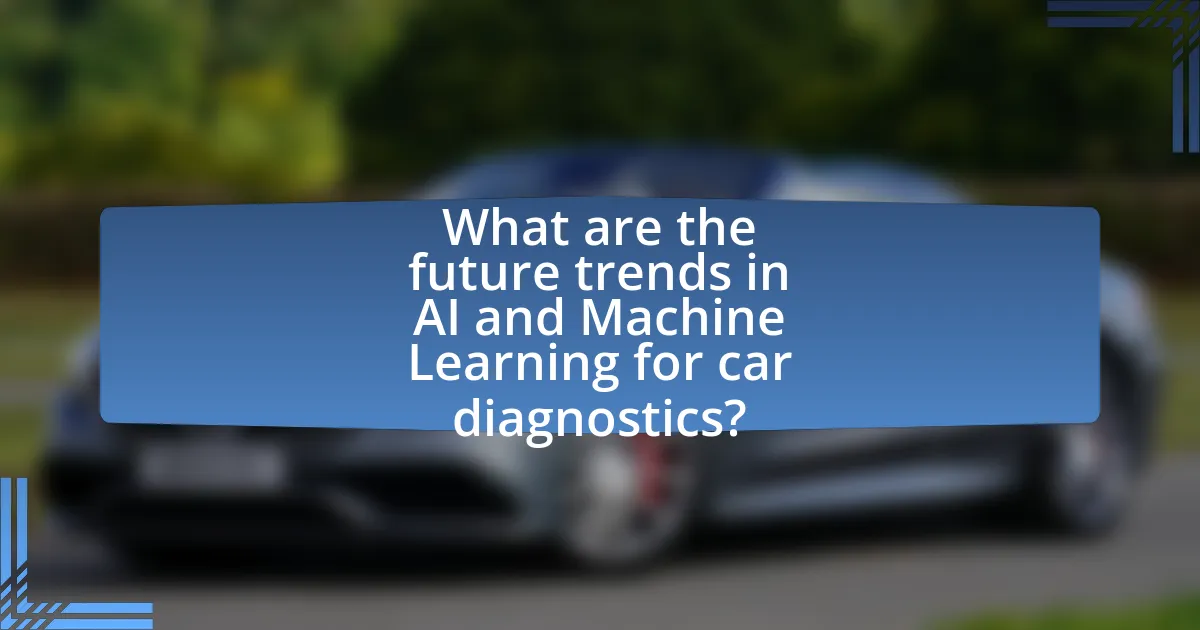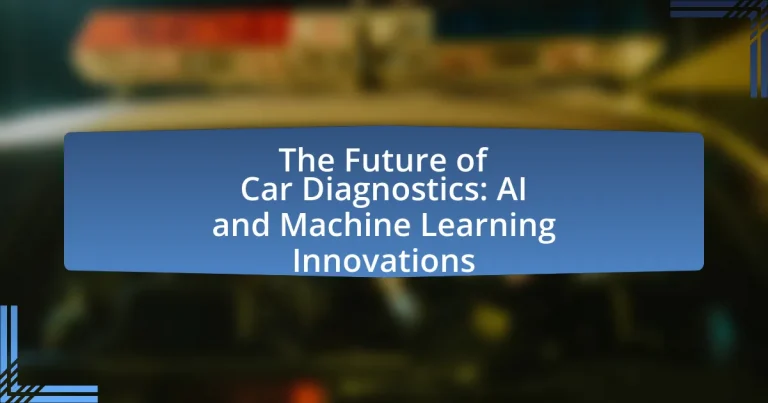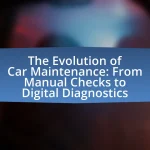The article focuses on the future of car diagnostics through the lens of artificial intelligence (AI) and machine learning (ML) innovations. It highlights how these technologies enhance predictive maintenance, improve diagnostic accuracy, and enable real-time data analysis, ultimately leading to reduced downtime and repair costs. Key benefits include significant cost savings, increased vehicle uptime, and the transformation of traditional diagnostic practices. The article also addresses challenges such as data quality, interpretability, and integration with existing systems, while emphasizing the importance of collaboration between tech companies and automakers to overcome these barriers and drive innovation in the automotive industry.

What is the Future of Car Diagnostics with AI and Machine Learning?
The future of car diagnostics with AI and machine learning is characterized by enhanced predictive maintenance, real-time data analysis, and improved accuracy in fault detection. AI algorithms will analyze vast amounts of vehicle data to predict potential failures before they occur, significantly reducing downtime and repair costs. For instance, a study by McKinsey & Company indicates that predictive maintenance can reduce maintenance costs by 20-25% and increase equipment uptime by 10-20%. Furthermore, machine learning models will continuously improve their diagnostic capabilities by learning from historical data, leading to more precise identification of issues. This evolution in car diagnostics will ultimately lead to safer and more efficient vehicles on the road.
How are AI and Machine Learning transforming traditional car diagnostics?
AI and Machine Learning are transforming traditional car diagnostics by enabling predictive maintenance and real-time data analysis. These technologies analyze vast amounts of vehicle data to identify potential issues before they become critical, significantly reducing downtime and repair costs. For instance, AI algorithms can process data from sensors and onboard diagnostics systems to detect patterns indicative of future failures, allowing for timely interventions. According to a study by McKinsey, the integration of AI in automotive diagnostics can lead to a 20-30% reduction in maintenance costs and improve vehicle uptime by up to 50%. This shift from reactive to proactive maintenance represents a fundamental change in how vehicle health is monitored and managed.
What specific technologies are being integrated into car diagnostics?
Artificial Intelligence (AI) and Machine Learning (ML) technologies are being integrated into car diagnostics to enhance vehicle maintenance and repair processes. These technologies enable predictive analytics, allowing for real-time monitoring of vehicle health and the identification of potential issues before they become critical. For instance, AI algorithms analyze data from various sensors to detect anomalies and predict failures, which can reduce downtime and repair costs. Additionally, diagnostic tools now utilize natural language processing to interpret user queries and provide tailored troubleshooting advice, improving user experience and efficiency in diagnostics.
How do these technologies improve diagnostic accuracy?
AI and machine learning technologies improve diagnostic accuracy by analyzing vast amounts of vehicle data to identify patterns and anomalies that human technicians may overlook. These technologies utilize algorithms that learn from historical data, enabling them to predict potential issues with greater precision. For instance, a study published in the Journal of Automotive Engineering demonstrated that AI-driven diagnostic tools could reduce error rates in identifying engine problems by up to 30%, compared to traditional methods. This enhanced capability leads to quicker and more reliable diagnostics, ultimately improving vehicle maintenance and safety.
What are the key benefits of AI and Machine Learning in car diagnostics?
AI and Machine Learning significantly enhance car diagnostics by improving accuracy, reducing diagnostic time, and enabling predictive maintenance. These technologies analyze vast amounts of data from vehicle sensors and historical repair records, allowing for precise identification of issues. For instance, a study by McKinsey & Company highlights that AI can reduce diagnostic time by up to 30%, leading to faster repairs and increased customer satisfaction. Additionally, predictive maintenance powered by machine learning algorithms can forecast potential failures before they occur, minimizing downtime and repair costs. This proactive approach not only enhances vehicle reliability but also optimizes service operations for automotive businesses.
How do these innovations enhance vehicle maintenance?
Innovations in AI and machine learning enhance vehicle maintenance by enabling predictive analytics that identify potential issues before they become critical. These technologies analyze vast amounts of data from vehicle sensors and historical maintenance records, allowing for timely interventions and reducing the likelihood of breakdowns. For instance, a study by McKinsey & Company found that predictive maintenance can reduce maintenance costs by up to 30% and increase vehicle uptime by 25%. This data-driven approach not only streamlines maintenance schedules but also optimizes resource allocation, ensuring that repairs are performed when necessary and minimizing unnecessary service visits.
What cost savings can be expected from implementing AI-driven diagnostics?
Implementing AI-driven diagnostics can lead to significant cost savings, estimated at up to 30% in operational expenses for automotive repair shops. These savings arise from reduced diagnostic time, increased accuracy in identifying issues, and minimized unnecessary repairs. For instance, a study by McKinsey & Company highlights that AI can decrease diagnostic time from hours to minutes, allowing technicians to handle more vehicles efficiently. Additionally, AI’s predictive maintenance capabilities can prevent costly breakdowns, further contributing to overall savings.

What challenges do AI and Machine Learning face in car diagnostics?
AI and Machine Learning face several challenges in car diagnostics, primarily including data quality, interpretability, and integration with existing systems. Data quality is crucial, as inaccurate or incomplete data can lead to erroneous diagnostics; for instance, a study by the National Institute of Standards and Technology found that poor data quality can reduce the effectiveness of machine learning models by up to 50%. Interpretability is another significant challenge, as many AI models operate as “black boxes,” making it difficult for technicians to understand how decisions are made, which can hinder trust and adoption. Additionally, integrating AI solutions with legacy systems in vehicles poses technical difficulties, as many existing diagnostic tools are not designed to work with advanced machine learning algorithms, leading to compatibility issues.
What are the technical limitations of current AI diagnostic systems?
Current AI diagnostic systems face several technical limitations, including data quality issues, lack of interpretability, and dependency on large datasets. Data quality issues arise from incomplete or biased datasets, which can lead to inaccurate diagnoses. The lack of interpretability means that many AI models operate as “black boxes,” making it difficult for users to understand how decisions are made, which can hinder trust and adoption. Additionally, these systems often require extensive labeled data for training, which can be challenging to obtain in the automotive sector, limiting their effectiveness in real-world applications.
How do data privacy concerns impact the adoption of AI in diagnostics?
Data privacy concerns significantly hinder the adoption of AI in diagnostics by creating barriers to data sharing and collaboration. Healthcare organizations are often reluctant to implement AI solutions due to fears of data breaches and non-compliance with regulations such as GDPR and HIPAA, which mandate strict data protection measures. For instance, a survey by McKinsey found that 70% of healthcare executives cited data privacy as a major obstacle to AI adoption. This reluctance limits the availability of high-quality data necessary for training AI models, ultimately stalling innovation and the potential benefits of AI in improving diagnostic accuracy and efficiency.
What are the barriers to integrating AI solutions in existing systems?
The barriers to integrating AI solutions in existing systems include data quality issues, lack of interoperability, high implementation costs, and resistance to change among stakeholders. Data quality issues arise when existing datasets are incomplete or inconsistent, making it difficult for AI algorithms to function effectively. Lack of interoperability refers to the challenges faced when integrating AI with legacy systems that may not support modern technologies or standards. High implementation costs can deter organizations from adopting AI solutions, as they often require significant investment in infrastructure and training. Finally, resistance to change among stakeholders, including employees and management, can hinder the adoption of AI technologies, as they may be hesitant to alter established workflows or processes.
How can the automotive industry overcome these challenges?
The automotive industry can overcome challenges by integrating AI and machine learning technologies into car diagnostics. These technologies enhance predictive maintenance, allowing for real-time monitoring and analysis of vehicle performance, which reduces downtime and repair costs. For instance, a study by McKinsey & Company indicates that predictive maintenance can reduce maintenance costs by up to 30% and increase vehicle uptime by 25%. Additionally, leveraging AI can improve the accuracy of diagnostics, enabling quicker identification of issues, which streamlines repair processes and enhances customer satisfaction. By adopting these innovations, the automotive industry can effectively address operational challenges and improve overall efficiency.
What role does collaboration between tech companies and automakers play?
Collaboration between tech companies and automakers plays a crucial role in advancing automotive technology, particularly in the areas of AI and machine learning for car diagnostics. This partnership enables the integration of sophisticated algorithms and data analytics into vehicles, enhancing predictive maintenance and real-time diagnostics. For instance, companies like Tesla have successfully utilized AI to improve vehicle performance and safety features, demonstrating the effectiveness of such collaborations. Furthermore, a report by McKinsey highlights that automakers leveraging tech partnerships can reduce development costs and accelerate innovation cycles, ultimately leading to smarter, more efficient vehicles.
How can regulatory frameworks support AI innovation in diagnostics?
Regulatory frameworks can support AI innovation in diagnostics by establishing clear guidelines that ensure safety, efficacy, and ethical use of AI technologies. These frameworks can facilitate the development and deployment of AI diagnostic tools by providing a structured pathway for approval, which encourages investment and innovation. For instance, the FDA’s Digital Health Innovation Action Plan has streamlined the approval process for software-based diagnostic tools, allowing for faster market entry while maintaining safety standards. This regulatory clarity not only fosters trust among developers and users but also promotes collaboration between industry stakeholders, ultimately leading to advancements in diagnostic capabilities.

What are the future trends in AI and Machine Learning for car diagnostics?
Future trends in AI and Machine Learning for car diagnostics include the integration of predictive maintenance, enhanced data analytics, and the use of advanced algorithms for real-time diagnostics. Predictive maintenance leverages machine learning models to analyze historical data and predict potential failures before they occur, reducing downtime and repair costs. Enhanced data analytics allows for the processing of vast amounts of vehicle data, enabling more accurate diagnostics and personalized maintenance recommendations. Advanced algorithms, including deep learning techniques, improve the accuracy of fault detection and diagnosis, leading to faster and more reliable service. These trends are supported by the increasing adoption of IoT devices in vehicles, which generate real-time data that can be utilized for more effective diagnostics.
How will predictive analytics shape the future of car diagnostics?
Predictive analytics will significantly enhance car diagnostics by enabling proactive maintenance and reducing unexpected failures. By analyzing historical data and real-time vehicle performance metrics, predictive analytics can identify patterns that indicate potential issues before they become critical. For instance, a study by McKinsey & Company highlights that predictive maintenance can reduce maintenance costs by 20-25% and increase equipment uptime by 10-20%. This data-driven approach allows manufacturers and service providers to optimize repair schedules, improve vehicle reliability, and enhance customer satisfaction through timely interventions.
What advancements in machine learning algorithms are expected?
Advancements in machine learning algorithms are expected to enhance predictive accuracy and efficiency in car diagnostics. Techniques such as deep learning, reinforcement learning, and transfer learning are anticipated to improve the ability of algorithms to analyze complex data patterns from vehicle sensors and historical maintenance records. For instance, deep learning models can process vast amounts of unstructured data, leading to better fault detection and predictive maintenance. Research indicates that these advancements will enable real-time diagnostics and proactive maintenance, reducing downtime and repair costs for vehicle owners.
How will real-time data processing change diagnostic practices?
Real-time data processing will significantly enhance diagnostic practices by enabling immediate analysis and feedback on vehicle performance. This capability allows technicians to identify issues as they occur, rather than relying on historical data or periodic inspections. For instance, systems equipped with real-time data processing can monitor engine parameters continuously, alerting mechanics to anomalies that may indicate potential failures. Research indicates that this proactive approach can reduce diagnostic time by up to 30%, leading to faster repairs and improved vehicle reliability. Furthermore, real-time insights facilitate more accurate predictions of maintenance needs, ultimately enhancing overall vehicle safety and performance.
What role will consumer preferences play in the evolution of car diagnostics?
Consumer preferences will significantly influence the evolution of car diagnostics by driving demand for more user-friendly, efficient, and technologically advanced solutions. As consumers increasingly prioritize convenience and real-time data access, car manufacturers and diagnostic tool developers will adapt their offerings to include features such as mobile app integration, predictive maintenance alerts, and enhanced user interfaces. For instance, a survey by McKinsey & Company found that 70% of consumers are willing to pay more for vehicles equipped with advanced diagnostic capabilities that provide insights into vehicle health and performance. This shift in consumer expectations will push the automotive industry to innovate and incorporate AI and machine learning technologies, ultimately leading to more accurate diagnostics and personalized vehicle maintenance experiences.
How can user-friendly interfaces enhance the adoption of AI diagnostics?
User-friendly interfaces enhance the adoption of AI diagnostics by simplifying interactions and improving accessibility for users. When interfaces are intuitive, they reduce the learning curve associated with complex AI systems, allowing technicians and users to quickly understand and utilize diagnostic tools. Research indicates that 70% of users prefer systems that are easy to navigate, which directly correlates with increased usage rates. Furthermore, user-friendly designs often incorporate visual aids and clear instructions, which can lead to more accurate diagnostics and quicker problem resolution, ultimately fostering trust in AI technologies.
What features do consumers prioritize in AI-driven diagnostic tools?
Consumers prioritize accuracy, ease of use, and real-time data analysis in AI-driven diagnostic tools. Accuracy ensures that the diagnostic tool provides reliable and precise information about vehicle issues, which is critical for effective repairs. Ease of use allows consumers to navigate the tool without extensive technical knowledge, making it accessible to a broader audience. Real-time data analysis enables immediate feedback and insights, allowing for timely decision-making regarding vehicle maintenance. These features are essential as they enhance user experience and trust in the technology, ultimately influencing purchasing decisions.
What practical tips can automotive professionals follow to adapt to these innovations?
Automotive professionals can adapt to innovations in AI and machine learning by investing in training programs focused on these technologies. Continuous education in AI applications, such as predictive maintenance and diagnostic tools, enhances skill sets and keeps professionals updated on industry advancements. According to a report by McKinsey, companies that invest in employee training see a 20% increase in productivity, demonstrating the value of upskilling in response to technological changes. Additionally, professionals should collaborate with tech companies to integrate AI solutions into their workflows, ensuring they leverage the latest tools effectively. Engaging in industry forums and workshops can also provide insights into best practices and emerging trends, further aiding adaptation to these innovations.


